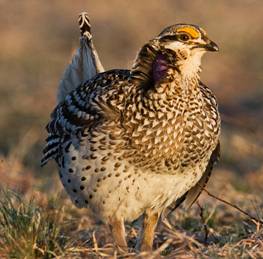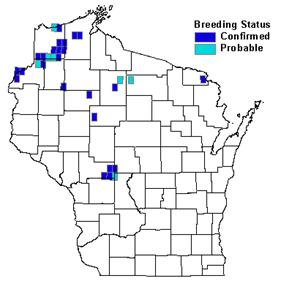Photo by Roy Scarth


Status/Protection
- Global Rank: G4 Key to global and state ranks
- State Rank: S1B, S2N
- WBCI Priority: SGCN, State Special Concern
Population Information
The Federal BBS information can be obtained at http://www.mbr-pwrc.usgs.gov/bbs/bbs.html by clicking on Trend Estimates and selecting the species in question. All estimates are for time period (1966-2005).
*Note: There are important deficiencies with these data. These results may be compromised by small sample size, low relative abundance on survey route, imprecise trends, and/or missing data. Caution should be used when evaluating this trend.
- Federal Breeding Bird Survey: non-significant decline
- Federal Breeding Bird Survey (WI): non-significant increase*
- Federal Breeding Bird Survey (BCR 23): N/A
- Federal Breeding Bird Survey (BCR 12): significant increase*
- WSO Checklist Project: declining (1983-2007)
Life History
- Breeding Range: Alaska east across Canada and the northern U.S. to west-central Quebec and northern Michigan (Connelly et al. 1998).
- Breeding Habitat: Pine Barrens, Northern Sedge Meadow and Marsh, Oak Opening, Open Bog-Muskeg, brush prairies, cut or burned-over forestland, early seral forestland, abandoned farmland.
- Nest: Ground, often under or near shrubs, tall trees or tall residual cover if available (Connelly et al. 1998).
- Nesting Dates: Eggs: mid-April to late June (Robbins 1991).
- Foraging: Ground glean, foliage browse (Ehrlich et al. 1988).
- Migrant Status: Permanent Resident.
- Habitat use during Migration: higher elevation forests, forest edge, some use of shrubby secondary woodland, trees in pastures (Morse 1993).
- Arrival Dates: N/A
- Departure Dates: N/A
- Winter Range: Same as breeding range.
- Winter Habitat: Same as above.
Habitat Selection
Sharp-tailed Grouse use a variety of habitat types in Wisconsin including brush prairie, barrens, cut or burned over forestland, wet meadows, pine/oak savannah, mixed deciduous-conifer forest, and abandoned farmland (Sample and Mossman 1997, Evrard et al. 2000, Gregg and Niemuth 2000, Niemuth 2006). Wherever they occur, dense herbaceous cover and shrubs are important habitat components (Connelly et al. 1998). Considered area-sensitive, Sharp-tailed Grouse require large open blocks of early successional habitat (Gregg 1987, Sample and Mossman 1997, Connelly et al. 1998, Niemuth and Boyce 2004, Niemuth 2006). In Minnesota, blocks of contiguous habitat must be at least 5 km2, and complexes of inter-connected smaller areas must contain parcels of at least 15 ha (Berg 1997). However, the exact amount of habitat needed to sustain a viable population likely varies by ecological landscape and state. Dancing grounds or leks are commonly found in more open areas (Sample and Mossman 1997), while nests are generally located in relatively heavy cover, often under or near shrubs or small trees (Connelly et al. 1998). Winter sites may contain higher shrub cover and less snow cover than random locations (Sample and Mossman 1997, Connelly et al. 1998).
Habitat Availability
Extensive sedge meadows and barrens habitats occurred in central and northern Wisconsin prior to settlement. Today, approximately 3% of moderate to high quality sedge meadows and 1% of barrens habitats remain (Mossman and Sample 1990, Mossman et al. 1991). Draining, ditching, cranberry farming, and grazing have all impacted sedge meadows (Mossman and Sample 1990). Grazing, cultivation, red pine conversion, and fire suppression have impacted barrens habitats (Mossman et al. 1991). Many of the early-successional habitats used by Sharp-tailed Grouse are ephemeral and threatened by succession and development.
Sharp-tailed Grouse populations occur principally on managed properties within the Northwest Sands, North Central Forest and Superior Coastal Plains Ecological Landscapes. Populations exist on private lands throughout these regions but their numbers and response to habitat conditions are less well-documented. In recent years, Crex Meadows Wildlife Area in Burnett County has had perhaps the largest and most stable population of any managed property (Evrard et al 2000, Mezera 2006). Several large wildlife areas in the Central Sand Plains Ecological Landscape have historically had Sharp-tailed Grouse populations, but their current numbers are low. Central Wisconsin may have great potential for increasing sharp-tail numbers with additional habitat management and timber harvest (Niemuth 2006).
Population Concerns
Midwestern Sharp-tailed Grouse populations have experienced long-term population declines and are in possible danger of extirpation from some states, including Wisconsin (Niemuth and Boyce 2004). They are uncommon residents in northern and central Wisconsin (Robbins 1991). In these regions, Wisconsin Breeding Bird Atlas observers confirmed breeding in just 2% of the surveyed quads from 1995-2000 (Niemuth 2006). Conventional survey methodologies often are not adequate for this species. It is rarely recorded on either the Wisconsin routes of the Breeding Bird Survey or the Wisconsin Checklist Project (Temple et al. 1997, Sauer et al. 2005).
Although Wisconsin’s population appears to be somewhat cyclical, long-term declines and range contraction continue (Gregg and Niemuth 2000, Mezera 2006) and local populations are becoming more and more isolated. Preliminary DNA analysis has shown some maintenance of genetic variation through dispersal among local populations, but probably not enough to sustain the state population over the long-term (B. Swanson, pers. comm.). Threats include habitat loss, fragmentation, wildfire suppression, and lack of timber harvest (Gregg 1987, Gregg and Niemuth 2000, Niemuth and Boyce 2004, Niemuth 2006).
Recommended Management
Sharp-tailed Grouse habitat is ephemeral (Niemuth 2006) and largely dependent on disturbance to maintain appropriate vegetative condition (Connelly et al. 1998). Habitat management efforts have traditionally focused on mowing, prescribed fire, and timber harvest in Wisconsin. However, recent research suggests that birds may respond more positively to new habitat created as a result of timber harvest (Connolly 2001). Sharp-tailed Grouse habitat management needs to occur in large continuous blocks of at least 100 hectares (Sample and Mossman 1997) and on a landscape scale. Emphasis should be placed on connecting or linking large core populations through partnerships among local, state and federal agencies as well as private landowners. Conservation and management strategies for this species should be focused in the following Wisconsin ecological landscapes: Northwest Sands, Central Sand Plains, North Central Forest, Northeast Sands, and Superior Coastal Plain (WDNR 2005).
Translocation of birds from both within and outside Wisconsin may be needed to increase the genetic diversity of existing populations and to restore birds to suitable, but currently unoccupied, habitat. Sharp-tailed Grouse harvest is tightly regulated through a permit and quota system. Overall harvest is very low at less than 5% of the total population (Gregg and Niemuth 2000) and probably is not contributing to the overall population decline of this species (Gregg 1987, Niemuth 2006). However, a regular review of the harvest management system is needed to ensure that the information being collected to manage this species is rigorous.
Research Needs
The Wisconsin Department of Natural Resources is currently reviewing and updating the statewide management plan for this species. Continued monitoring at known lek locations in the state is needed. Additional research and monitoring efforts to identify new lek locations on private lands and evaluate their importance to the overall statewide population is warranted. Studies that investigate the minimum area requirement for sustaining viable populations also are needed.
Information Sources
- Managing Habitat for Grassland Birds: A Guide for Wisconsin: http://www.npwrc.usgs.gov/resource/birds/wiscbird/
- North American Breeding Bird Survey: http://www.mbr-pwrc.usgs.gov/bbs/bbs.html
- Temple S.A., J.R. Cary, and R. Rolley. 1997. Wisconsin Birds: A Seasonal and Geographical Guide. Wisconsin Society of Ornithology and Wisconsin Department of Natural Resources, Madison, WI.
- Wisconsin Breeding Bird Atlas: http://www.uwgb.edu/birds/wbba/
- Wisconsin Sharp-tailed Grouse Society
- Scott Hull, Upland Wildlife Ecologist, Wisconsin DNR - 608-267-7861
- David Sample, Grassland Community Ecologist, Wisconsin DNR - 608-221-6351
References
- Connelly, J.W., M.W. Gratson, and K.P. Reese. 1998. Sharp-tailed Grouse. In the Birds of North America, No. 36 (A. Poole, P. Stettenheim, and F. Gill, eds.). Philadelphia: The Academy of Natural Sciences; Washington, D.C.: The American Ornithologists’ Union.
- Connolly, T.T. 2001. Reproductive ecology of sharp-tailed grouse in the pine barrens of northwestern Wisconsin. M.S. Thesis, University of Wisconsin, Stevens Point.
- Ehrlich, P.R., D.S. Dobkin, and D. Wheye. 1988. The birders handbook: a field guide to the natural history of North American birds. Simon & Schuster, Inc. New York.
- Evrard, J.O., J.E. Hoefler, and P.A. Kooiker. 2000. The history of sharp-tailed grouse in the Crex Meadows Wildlife Area. Passenger Pigeon 62:175-183.
- Gregg, L. 1987. Recommendations for a program of sharptail habitat preservation in Wisconsin. Wisconsin Department of Natural Resources, Research Report, no. 141.
- Gregg, L.E. and N.D. Niemuth. 2000. History, status, and management of sharp-tailed grouse in Wisconsin. Passenger Pigeon 62: 159-174.
- Mezera, A. 2006. Wisconsin Sharptail Grouse Status – 2006. Wisconsin Department of Natural Resources.
- Niemuth, N. 2006. Sharp-tailed Grouse (Tympanuchus phasianellus). In Atlas of the Breeding Birds of Wisconsin. (N.J. Cutright, B.R. Harriman, and R.W. Howe, eds.) The Wisconsin Society for Ornithology, Inc. 602pp.
- Niemuth, N.D., and M.S. Boyce. 2004. Influence of landscape composition on sharp-tailed grouse lek location and attendance in Wisconsin pine barrens. Ecoscience 11:209-217.
- Robbins, S.D. 1991. Wisconsin birdlife: population & distribution, past & present. Univ. of Wisconsin Press, Madison, WI.
- Sample, D. and M. Mossman. 1997. Managing Habitat for Grassland Birds: A guide for Wisconsin. Wisconsin Department of Natural Resources: Madison, WI.
- Wisconsin Department of Natural Resources (WDNR). 2005. Wisconsin’s Strategy for Wildlife Species of Greatest Conservation Need. Madison, WI.
Contact Information
- Compiler: Scott Hull, Scott.Hull@Wisconsin.gov
- Editor: Kim Kreitinger, K.Kreitinger@gmail.com
